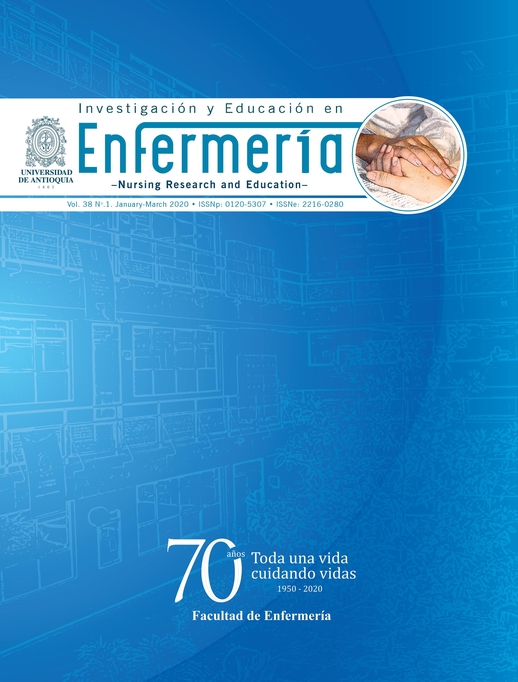Effectiveness of Milieu Therapy in reducing conflicts and containment rates among schizophrenia patients
DOI:
https://doi.org/10.17533/udea.iee.v38n1e06Keywords:
Schizophrenia, inpatients, psychiatric department, hospital, milieu therapy, aggression, self-injurious behaviorAbstract
Objective. To evaluate effectiveness of Milieu Therapy in reduction of conflict and containment rates among schizophrenia patients.
Methods. This study utilized quasi experimental non-equivalent control group pre-post design. One hundred schizophrenia patients admitted in acute psychiatric wards were non-randomly assigned to either of the experimental (n=50) or control group (n=50). The experimental group received both milieu therapy and routine hospital treatment. The Milieu Therapy intervention Included environmental modification and structuring ward activities, establishing effective interaction with patient, and teaching caregivers on managing conflict behavior of patient. The control group received only routine treatment in the hospital. Outcome measures on conflict and containment rates were evaluated for both the groups at baseline and at 2nd, 3rd and 15th day. The Patient–Staff Conflict Checklist Shift Report (PCC-SR) was used to collect information about rates of conflict and containment.
Results. Compared with control group, the experimental group participants showed decrease in aggressive behavior, self-harm behavior and general rule breaking behavior at baseline and 2nd, 3rd and 15th day (F=4.61, p<0.004, η2=0.04; F=11.92, p<0.001, η2=0.11; F=6.94, p<0.001, η2=0.06) over seven days interval.
Conclusion. The present study findings provided evidence for the effectiveness of integrating Milieu Therapy in psychiatric acute wards in reducing conflict behaviors among schizophrenia patients. Milieu therapy should be considered as an integral part of psychiatric care settings in these patients.
How to cite this article: Bhat S, Rentala S, BN Raveesh, Chellappan XB. Effectiveness of Milieu Therapy in reducing conflicts and containment rates among schizophrenia patients. Invest. Educ. Enferm. 2020; 38(1):e06.
Downloads
References
(1) Bowers L, Simpson A, Alexander J. Patient-staff conflict: Results of a survey on acute psychiatric wards. Soc. Psychiatry Psychiatr. Epidemiol. 2003; 38(7):402–8
(2) Bowers L. On conflict, containment and the relationship between them. Nurs. Inq. 2006;13(3):172–80.
(3) Slemon A, Jenkins E, Bungay V. Safety in psychiatric inpatient care: The impact of risk management culture on metnal health nursing practice. Nurs. Inq. 2017: 24(4);12190-95.
(4) Huf G, Coutinho FS, Fagundes MH, Oliveira SE, Keusen A, Adams EC. Current practices in managing acutely disturbed patients at three hospitals in Rio de Janeiro-Brazil: a prevalence study. BMC Psychiatry. 2002; 2:4-6.
(5) Bowers L. Safe wards: a new model of conflict and containment on psychiatric wards. J. Psychiatr. Ment. Health Nurs. 2014; 21:499–508.
(6) Bowers L, James K, Quirk A, Simpson A, Stewart D, Hodsoll J. Reducing conflict and containment rates on acute psychiatric wards: The Safewards cluster randomised controlled trial. Int .J. Nurs. Stud. 2015; 52(9):1412-22.
(7) Caesar GL. The importance of a psychiatric Milieu in Inpatients setting. DNP Capstone Project 2015. 2015 [cited 7 Feb 2020]. Available from: http://www.nursinglibrary.org/vhl/handle/10755/550535
(8) Ergun G, Isik I, Dikec G. Roles of psychiatric nurses within a therapeutic environment of psychiatriy clinics in Turkey. Arch. Psychiatr. Nurs. 2017; 31:245-55.
(9) Roberts G. Risk Decision-Making: working with risk and implementing positive risk-taking (manual with CD-ROM). Br. J. Psychiatr. 2014; 204:411.
(10) Irwin A. The nurse’s role in the management of aggression. J. Psychiatr. Ment. Health Nurs. 2006; 13:309–18.
(11) Baby M, Glue P, Carlyle D. ‘Violence is not part of our job’: a thematic analysis of psychiatric mental health nurses’ experiences of patient assaults from a New Zealand perspective. Issues Ment. Health Nurs. 2014; 35:647–55.
(12) Arnetz JE, Arnetz BB. Violence towards health care staff and possible effects on the quality of patient care. Soc. Sci. Med. 2001; 52:417–27.
(13) Bilgin H, Buzlu S. A study of psychiatric nurses’ beliefs and attitudes about work safety and assaults in Turkey. Issues Ment. Health Nurs. 2006; 27:75–90.
(14) Daffern M, Howells K. Psychiatric inpatient aggression: a review of structural and functional assessment approaches. Aggress Violent Behav. 2002; 7:477–97.
(15) Bowers L, Flood C, Brennan G, Allan T. A replication study of the city nurses intervention: reducing conflict and containment on three acute psychiatric wards. J. Psychiatr. Ment. Health Nurs. 2008; 15:737–742.
(16) Bowers L, James K, Quirk A, Simpson A, Stewart D, Hodsoll J. Reducing conflict and containment rates on acute psychiatric wards: The Safewards cluster randomised controlled trial. Int J. Nurs Stud. 2015;52(9):1412-22.
(17) Chizh C. Ensuring Milieu safety in a forensic psychiatric unit. Nursing. 2015; 45(9):63-65.
(18) Bowers L, Nijman H, Grange A, et al. A longitudinal study of conflict and containment on acute psychiatric wards: Report to the DH Policy Research Programme. London: City University ; 2007.
(19) Eliassen BK, Sørlie T1, Sexton J, Høifødt TS. The effect of training in mindfulness and affect consciousness on the therapeutic environment for patients with psychoses: an explorative intervention study. Scand. J. Caring Sci. 2016; 30(2):391-402.
(20) Jakhar K, Beniwal PR, Bhatia T, Deshpande NS. Self-harm and suicide attempts in schizophrenia. Asian J. Psychiatr. 2017; 30:102-106.
(21) Alexander J, Bowers L. Acute psychiatric ward rules: a review of the literature. J. Psychiatr. Ment. Health Nurs. 2004; 11(5):623-31.
Downloads
Published
How to Cite
Issue
Section
License
Copyright (c) 2020 Investigación y Educación en Enfermería

This work is licensed under a Creative Commons Attribution-NonCommercial-ShareAlike 4.0 International License.
Derechos de propiedad / Direitos de Propriedade
English: If the article is accepted for publication, all copyright will be of exclusive property of Investigación y Educación en Enfermería. The text and the graphics included in the publication are exclusive responsibility of the authors and not necessarily reflect the thought of the Editorial Committee.
Español: Si el artículo es aprobado para publicación, todos los derechos son de propiedad de Investigación y Educación en Enfermería. El texto y las gráficas incluidas en la publicación son de exclusiva responsabilidad de los autores y no necesariamente refleja el pensamiento del Comité Editorial.
Português: Se o artigo for aceito para publicação, todos os direitos autorais serão de propriedade exclusiva de Investigación y Educación en Enfermería. O texto e os gráficos incluídos na publicação são de responsabilidade exclusiva dos autores e não refletem necessariamente o pensamento do Comitê Editorial.















